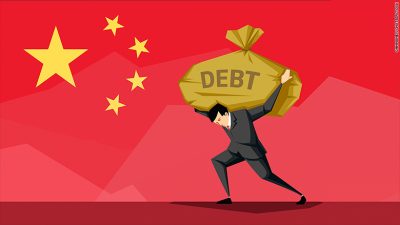The Beidaihe Political Summit: Is the “Chinese Dream” Still Viable? China’s Debt Crisis

The resort town of Beidaihe has just held one of the world’s most important, and secretive, political gatherings. Members of the public flock there in the summer months to relax on the beach gently lapped by the shallow waters of the Yellow Sea. But far from the madding crowd, the resort, 200 km north of Beijing, hosts an annual sealed-off conclave of Communist party luminaries, including President Xi Jinping, for a month from mid-July. The leaders set out the agenda for the year and prioritize the issues facing them. They were not short of topics for discussion. Though the annual event is held in the utmost secrecy, it is a racing certainty that US arms sales to Taiwan, a trade war, a stuttering economy, Beijing’s treatment of the Muslim Uighurs in the western region of Xinjiang and mass protests in Hong Kong as well as growing debt will have featured. So too would have planned celebrations marking the party’s 70 years in power on October 1. Only one of these issues is considered a clear and present danger to those who gathered in the resort.
The mass detention of members of the Uighur community in Xinjiang, designated an autonomous region, in China’s west, has not met with loud international criticism, even among Muslim countries. Consequently, Beijing feels it has a free hand and will not face any real repercussions. Providing Beijing can keep the army out of Hong Kong, it, too, should be manageable. Certainly Washington will not make waves. In Trump’s White House, Greenland is held in higher esteem. Brexit-preoccupied London can’t and won’t get involved.
There is no indication that the Hong Kong government wants troops to be sent in from across the border in Shenzhen.
Legally, the army stepping in must be initiated by the Hong Kong government, though the standing committee of the National People’s Congress in Beijing can declare a state of emergency in Hong Kong if turmoil “endangers national unity or security.”
In practice, any decision would be made by China’s leader, Xi, with the endorsement of the seven-member Politburo Standing Committee, the highest level of political power in China.
Both geographically and politically, Xinjiang and Hong Kong are on the periphery. All bets are off should the Hong Kong protests seep across the border to Shenzhen, but that seems unlikely, providing there is no crackdown. In truth, Beijing knows there is little sympathy for Hong Kong on the mainland.
Taiwan? Nothing realistically Beijing can do. Protest to Washington. Done that. Boost the fleet presence near the Taiwan straits. Done that. Conflict is not an option.
Trade war? The United States launched it, China has responded, doesn’t want it but can live with it. Exports from China to the US are a relatively small part of its GDP. The trade war with the US is a bad head cold, not a fatal disease.
Net exports as a percentage of China’s economy have shrunk sharply for years and now are under 1 percent of total GDP. China’s exports to the US make up just 5 percent of total exports. Even though China’s US exports fell nearly 8 percent in June, the result is not exactly a death blow to the nation’s $13.6 trillion economy.
Besides, blaming the US for targeting China and curtailing its growth could pay domestic dividends.
The real issue? A long time ago, in a faraway place from Beijing, it was the economy.
Same today for China. Especially debt. China is one of the most indebted countries in the world. By one measure, China’s debt has already passed 300 percent of gross domestic product. The Washington-based Institute of International Finance said China’s total corporate, household and government debt rose to 303 percent of GDP in the first quarter of 2019, up from 297 percent over the year. This is mostly financed by Chinese banks and off-the record lending by financial institutions in the “shadow bank” sector to provincial governments. Banks in China have actually been pressured not to cut back but to lend more. Beijing has unveiled billions of dollars in tax cuts and infrastructure spending. The world’s second-largest economy had the weakest quarterly growth since 1992, though officially at 6.2 percent is still beyond the wildest dreams of most economies. Universities and higher-education institutes churned out 8.3 million graduates into the job market in the summer. They need jobs, not just for their own welfare but to show that the “Chinese Dream” is still viable. An International Monetary Fund report in 2016 showed that of the 43 economies whose credit-to-GDP ratio grew by at least 30 percentage points in the previous five years, 38 “experienced severe disruptions, manifested in financial crises, growth slowdowns, or both’’. China’s total credit-to-GDP ratio from 2012-17 grew by 48.4 percentage points.
Deflating the debt bubble is difficult when global events such as recessions, and slow economic growth, demand another shot of stimulus. Much of the cash injection goes into the bloated veins of inefficient state-owned enterprises that are important for maintaining high employment levels. Beijing then gets an ever-decreasing bang for their buck in terms of any lasting impact on the economy. Over-building has been one of the responses. It is estimated that more than 20 percent of homes, the vast majority apartments in high rise buildings, in China are empty.
The unwritten agreement in China is economic growth for obedience which is why the issue of debt, and how to eventually tackle it, strikes at the heart of the political system. No other dilemma facing those who gathered in Beidaihe comes close in its potential consequences.
*
Note to readers: please click the share buttons below. Forward this article to your email lists. Crosspost on your blog site, internet forums. etc.
Tom Clifford is an Irish journalist based in China.
Featured image is from Shutterstock

